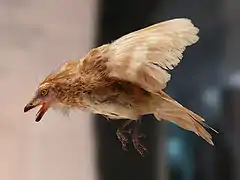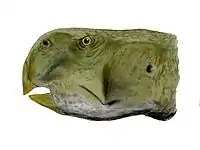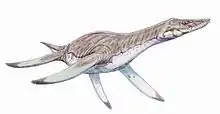Hauterivian
The Hauterivian is, in the geologic timescale, an age in the Early Cretaceous epoch or a stage in the Lower Cretaceous series. It spans the time between 132.9 ± 2 Ma and 129.4 ± 1.5 Ma (million years ago). The Hauterivian is preceded by the Valanginian and succeeded by the Barremian.[2]
| Hauterivian | |
|---|---|
| ~132.6 – ~129.4 Ma | |
| Chronology | |
Key events in the Cretaceous -140 — – -130 — – -120 — – -110 — – -100 — – -90 — – -80 — – -70 — – An approximate timescale of key Cretaceous events. Axis scale: millions of years ago. | |
| Etymology | |
| Name formality | Formal |
| Usage information | |
| Celestial body | Earth |
| Regional usage | Global (ICS) |
| Time scale(s) used | ICS Time Scale |
| Definition | |
| Chronological unit | Age |
| Stratigraphic unit | Stage |
| Time span formality | Formal |
| Lower boundary definition | FAD of the Ammonite genus Acanthodiscus |
| Lower boundary GSSP | La Charce, Drôme, France 44.4694°N 5.4437°E |
| GSSP ratified | December 2019[1] |
| Upper boundary definition | Not formally defined |
| Upper boundary definition candidates | FAD of the Spitidiscus hugii-Spitidiscus vandeckii Ammonite group |
| Upper boundary GSSP candidate section(s) | Río Argos, Caravaca de la Cruz, Murcia Province, Spain |
Stratigraphic definitions
The Hauterivian was introduced in scientific literature by Swiss geologist Eugène Renevier in 1873. It is named after the Swiss town of Hauterive at the shore of Lake Neuchâtel.
The base of the Hauterivian is defined as the place in the stratigraphic column where the ammonite genus Acanthodiscus first appears. A reference profile for the base (a GSSP) was officially ratified by the International Union of Geological Sciences in December of 2019, and is placed in La Charce, France.[1] The top of the Hauterivian (the base of the Barremian) is at the first appearance of ammonite species Spitidiscus hugii.
In the ammonite biostratigraphy of the Tethys domain, the Hauterivian contains seven ammonite biozones:
- zone of Pseudothurmannia ohmi
- zone of Balearites balearis
- zone of Plesiospitidiscus ligatus
- zone of Subsaynella sayni
- zone of Lyticoceras nodosoplicatus
- zone of Crioceratites loryi
- zone of Acanthodiscus radiatus
Palaeontology
Birds (avian theropods)
| Birds of the Hauterivian | ||||
|---|---|---|---|---|
| Taxa | Presence | Location | Description | Images |
| Disputed Berriasian-Hauterivian | Auxerre, Yonne, France | |||
| Hauterivian to Barremian | La Huérgina Formation, Castilla-la-Mancha, Spain | |||
Crocodylomorphs
| Crocodylomorphs of the Albian | ||||
|---|---|---|---|---|
| Taxa | Presence | Location | Description | Images |
|
Tunisia | A teleosaurid and one of the largest thalattosuchians that ever lived. | ||
|
Brazil | A tethysuchian neosuchian. One of the largest crocodylomoprhs to ever live. | ||
†Ornithischians
| Ornithischians of the Hauterivian | ||||
|---|---|---|---|---|
| Taxa | Presence | Location | Description | Images |
|
| ||||
| Isle of Wight, England | A dryosaurid | |||
Mammalia (mammals)
| Mammals of the Hauterivian | ||||
|---|---|---|---|---|
| Taxa | Presence | Location | Description | Images |
| several species from Hauterivian to Albian | Spain, Mongolia | |||
†Plesiosaurs
| Plesiosaurs of the Hauterivian | ||||
|---|---|---|---|---|
| Taxa | Presence | Location | Description | Images |
†Pterosauria
| Pterosaurs of the Hauterivian | ||||
|---|---|---|---|---|
| Taxa | Presence | Location | Description | Images |
| Berriasian-Albian | UK | |||
| Disputed, considered Tithonian by some | ||||
†Sauropods
| Sauropods of the Hauterivian | ||||
|---|---|---|---|---|
| Taxa | Presence | Location | Description | Images |
†Theropods (non-avian)
| Non-Avian Theropods of the Hauterivian | ||||
|---|---|---|---|---|
| Taxa | Presence | Location | Description | Images |
| Hauterivian to Barremian | Shinekhudug Formation, Eastern Gobi province, Mongolia |
| ||
| Valanginian to Hauterivian | Thailand | |||
| Berriasian to Barremian | Sao Khua Formation, Thailand | |||
†Ammonites
| Ammonites of the Hauterivian | ||||
|---|---|---|---|---|
| Taxa | Presence | Location | Description | Images |
| Czech Republic | ||||
| Argentina | ||||
References
Notes
- Mutterlose, Jörg; Rawson, Peter; Reboulet, Stéphane; Baudin, François; Bulot, Luc; Emmanuel, Laurent; Gardin, Silvia; Martinez, Mathieu; Renard, Maurice (September 2020). "The Global Boundary Stratotype Section and Point (GSSP) for the base of the Hauterivian Stage (Lower Cretaceous), La Charce, southeast France". Episodes. doi:10.18814/epiiugs/2020/020072. Retrieved 24 December 2020.
- See Gradstein et al. (2004) for a detailed geologic timescale
Literature
- Gradstein, F.M.; Ogg, J.G. & Smith, A.G.; (2004): A Geologic Time Scale 2004, Cambridge University Press.
External links
- GeoWhen Database - Hauterivian
- Mid-Cretaceous timescale, at the website of the subcommission for stratigraphic information of the ICS
- Stratigraphic chart of the Lower Cretaceous, at the website of Norges Network of offshore records of geology and stratigraphy
- Hauterivian Microfossils: 25+ images of Foraminifera





